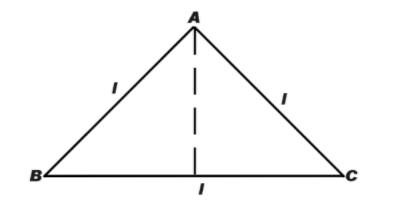
Three identical rods, each of length l, are joined to form a rigid equilateral triangle. Its radius of gyration about an axis passing through a corner and perpendicular to the plane of the triangle is
A. \[\dfrac{l}{2}\]
B. \[\sqrt{\dfrac{3}{2}}l\]
C. \[\dfrac{l}{\sqrt{2}}\]
D. \[\dfrac{l}{\sqrt{3}}\]
Answer
569.1k+ views
Hint: In this question we are asked to calculate the radius of gyration about an axis passing through one of corner points and perpendicular to the plane of triangle. Therefore, we will be calculating the moment of inertia of all the rods about the given point. Later, we will calculate the radius of gyration by using the formula that states the relation between total moment of inertia and radius of gyration.
Formula Used:
\[M{{k}^{2}}={{I}_{t}}\]
Where,
\[{{I}_{t}}\] is the total moment of inertia about point
k is the radius of gyration
M is the total mass of system
Complete answer:
It is given that three rods of equal length form a rigid equilateral triangle as shown in the figure below.

We know that radius of gyration is given by,
\[M{{k}^{2}}={{I}_{t}}\] ………………….. (A)
Therefore, we need to calculate the value of \[{{I}_{t}}\]. To calculate it we will first calculate the moment of inertia of each individual rod.
We know, that rods AB and AC are similar in every way as they form sides of equilateral triangle
Therefore, the moment of inertia of Ab will be equal to AC.
We know that MOI about an endpoint is given as \[\dfrac{m{{l}^{2}}}{3}\]
Therefore,
\[{{I}_{AB}}={{I}_{AC}}=\dfrac{m{{l}^{2}}}{3}\]
MOI for BC, we will be using parallel axis theorem
Therefore,
\[{{I}_{BC}}=\dfrac{m{{l}^{2}}}{12}+m{{r}^{2}}\] ………………….. (2)
From the figure, we can say
\[{{r}^{2}}={{l}^{2}}-\dfrac{{{l}^{2}}}{4}\] …………………. (Pythagoras theorem)
Therefore,
\[{{r}^{2}}={{\dfrac{3l}{4}}^{2}}\]
After substituting the value of r in equation (2)
We get,
\[{{I}_{BC}}=\dfrac{m{{l}^{2}}}{12}+m{{\dfrac{3l}{4}}^{2}}\]
Therefore,
\[{{I}_{BC}}=\dfrac{10m{{l}^{2}}}{12}\]
Now,
\[{{I}_{t}}={{I}_{AB}}+{{I}_{AC}}+{{I}_{BC}}\]
Substitute values from (1) and (2)
We get,
\[{{I}_{t}}=\dfrac{m{{l}^{2}}}{3}+\dfrac{10m{{l}^{2}}}{12}\]
Therefore,
\[{{I}_{t}}=\dfrac{3m{{l}^{2}}}{2}\]
The total mass of system is 3m
Substituting these values in (A)
We get,
\[3m{{k}^{2}}={{I}_{t}}\]
Therefore,
\[{{k}^{2}}=\dfrac{3m{{l}^{2}}}{2}\times \dfrac{1}{3m}\]
On solving,
\[{{k}^{2}}=\dfrac{{{l}^{2}}}{2}\]
Therefore, the radius of gyration
\[k=\dfrac{l}{\sqrt{2}}\]
Therefore, the correct answer is option C.
Note:
Radius of gyration is the distance from the given axis at which the mass of the body can be assumed to be concentrated and at which the moment of inertia would be equal to the moment of inertia of the original mass about the axis. Moment of inertia is a quantity that determines the torque needed for the angular acceleration of the object about the rotational axis.
Formula Used:
\[M{{k}^{2}}={{I}_{t}}\]
Where,
\[{{I}_{t}}\] is the total moment of inertia about point
k is the radius of gyration
M is the total mass of system
Complete answer:
It is given that three rods of equal length form a rigid equilateral triangle as shown in the figure below.

We know that radius of gyration is given by,
\[M{{k}^{2}}={{I}_{t}}\] ………………….. (A)
Therefore, we need to calculate the value of \[{{I}_{t}}\]. To calculate it we will first calculate the moment of inertia of each individual rod.
We know, that rods AB and AC are similar in every way as they form sides of equilateral triangle
Therefore, the moment of inertia of Ab will be equal to AC.
We know that MOI about an endpoint is given as \[\dfrac{m{{l}^{2}}}{3}\]
Therefore,
\[{{I}_{AB}}={{I}_{AC}}=\dfrac{m{{l}^{2}}}{3}\]
MOI for BC, we will be using parallel axis theorem
Therefore,
\[{{I}_{BC}}=\dfrac{m{{l}^{2}}}{12}+m{{r}^{2}}\] ………………….. (2)
From the figure, we can say
\[{{r}^{2}}={{l}^{2}}-\dfrac{{{l}^{2}}}{4}\] …………………. (Pythagoras theorem)
Therefore,
\[{{r}^{2}}={{\dfrac{3l}{4}}^{2}}\]
After substituting the value of r in equation (2)
We get,
\[{{I}_{BC}}=\dfrac{m{{l}^{2}}}{12}+m{{\dfrac{3l}{4}}^{2}}\]
Therefore,
\[{{I}_{BC}}=\dfrac{10m{{l}^{2}}}{12}\]
Now,
\[{{I}_{t}}={{I}_{AB}}+{{I}_{AC}}+{{I}_{BC}}\]
Substitute values from (1) and (2)
We get,
\[{{I}_{t}}=\dfrac{m{{l}^{2}}}{3}+\dfrac{10m{{l}^{2}}}{12}\]
Therefore,
\[{{I}_{t}}=\dfrac{3m{{l}^{2}}}{2}\]
The total mass of system is 3m
Substituting these values in (A)
We get,
\[3m{{k}^{2}}={{I}_{t}}\]
Therefore,
\[{{k}^{2}}=\dfrac{3m{{l}^{2}}}{2}\times \dfrac{1}{3m}\]
On solving,
\[{{k}^{2}}=\dfrac{{{l}^{2}}}{2}\]
Therefore, the radius of gyration
\[k=\dfrac{l}{\sqrt{2}}\]
Therefore, the correct answer is option C.
Note:
Radius of gyration is the distance from the given axis at which the mass of the body can be assumed to be concentrated and at which the moment of inertia would be equal to the moment of inertia of the original mass about the axis. Moment of inertia is a quantity that determines the torque needed for the angular acceleration of the object about the rotational axis.
Recently Updated Pages
Master Class 12 Business Studies: Engaging Questions & Answers for Success

Master Class 12 Economics: Engaging Questions & Answers for Success

Master Class 12 English: Engaging Questions & Answers for Success

Master Class 12 Maths: Engaging Questions & Answers for Success

Master Class 12 Social Science: Engaging Questions & Answers for Success

Master Class 12 Chemistry: Engaging Questions & Answers for Success

Trending doubts
What is meant by exothermic and endothermic reactions class 11 chemistry CBSE

Which animal has three hearts class 11 biology CBSE

10 examples of friction in our daily life

One Metric ton is equal to kg A 10000 B 1000 C 100 class 11 physics CBSE

1 Quintal is equal to a 110 kg b 10 kg c 100kg d 1000 class 11 physics CBSE

Difference Between Prokaryotic Cells and Eukaryotic Cells




